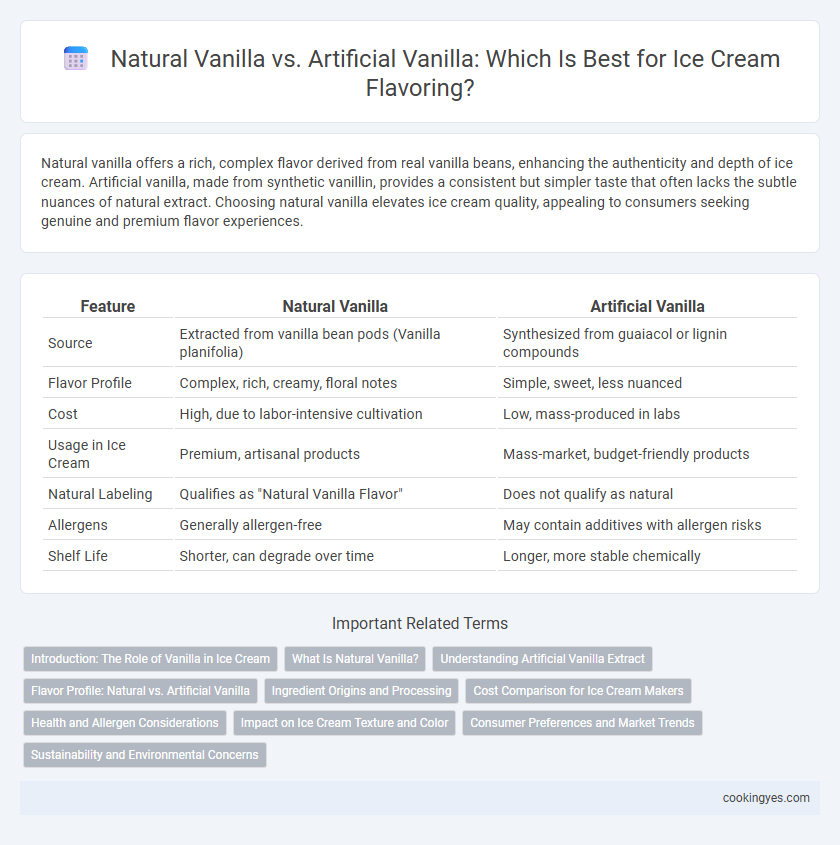Natural vanilla offers a rich, complex flavor derived from real vanilla beans, enhancing the authenticity and depth of ice cream. Artificial vanilla, made from synthetic vanillin, provides a consistent but simpler taste that often lacks the subtle nuances of natural extract. Choosing natural vanilla elevates ice cream quality, appealing to consumers seeking genuine and premium flavor experiences.
Table of Comparison
| Feature | Natural Vanilla | Artificial Vanilla |
|---|---|---|
| Source | Extracted from vanilla bean pods (Vanilla planifolia) | Synthesized from guaiacol or lignin compounds |
| Flavor Profile | Complex, rich, creamy, floral notes | Simple, sweet, less nuanced |
| Cost | High, due to labor-intensive cultivation | Low, mass-produced in labs |
| Usage in Ice Cream | Premium, artisanal products | Mass-market, budget-friendly products |
| Natural Labeling | Qualifies as "Natural Vanilla Flavor" | Does not qualify as natural |
| Allergens | Generally allergen-free | May contain additives with allergen risks |
| Shelf Life | Shorter, can degrade over time | Longer, more stable chemically |
Introduction: The Role of Vanilla in Ice Cream
Vanilla plays a crucial role in ice cream by enhancing flavor complexity and masking undesirable dairy notes. Natural vanilla, derived from vanilla bean pods, offers a rich, aromatic profile with subtle floral and smoky undertones that elevate premium ice cream. In contrast, artificial vanilla, primarily composed of synthetic vanillin, provides a more straightforward, consistent sweetness commonly used for cost-effective mass production.
What Is Natural Vanilla?
Natural vanilla is derived from the cured seed pods of the Vanilla planifolia orchid, containing naturally occurring vanillin along with hundreds of other flavor compounds that contribute to its complex, rich taste. This natural extract is obtained through traditional extraction methods such as solvent extraction or CO2 extraction, ensuring authentic aroma and flavor profiles. Unlike artificial vanilla, which uses synthetic vanillin, natural vanilla provides a more nuanced depth and subtle floral and fruity notes crucial for premium ice cream flavoring.
Understanding Artificial Vanilla Extract
Artificial vanilla extract, primarily composed of vanillin derived from synthetic sources like lignin or petrochemicals, offers a cost-effective and consistent flavor solution for ice cream production. Unlike natural vanilla extract, which contains a complex mix of hundreds of flavor compounds from vanilla beans, artificial vanilla provides a single dominant flavor molecule, resulting in a simpler yet potent vanilla taste. This distinction significantly influences the aroma, flavor complexity, and price point of ice cream products utilizing natural versus artificial vanilla flavoring.
Flavor Profile: Natural vs. Artificial Vanilla
Natural vanilla offers a complex flavor profile characterized by rich, creamy, and floral notes with subtle hints of spice and sweetness. Artificial vanilla, typically made from synthetic vanillin, provides a straightforward, one-dimensional taste that lacks the depth and nuanced aroma found in natural extracts. Ice cream flavored with natural vanilla tends to deliver a more authentic and layered sensory experience compared to the sharper and simpler flavor of artificial vanilla.
Ingredient Origins and Processing
Natural vanilla for ice cream flavoring is derived from vanilla bean pods, involving complex harvesting and curing processes to extract its rich, aromatic compounds. Artificial vanilla, or vanillin, is synthetically produced from petrochemicals or lignin, offering a consistent but less nuanced flavor profile. The ingredient origin and processing significantly impact the authenticity and depth of vanilla taste in ice cream formulations.
Cost Comparison for Ice Cream Makers
Natural vanilla, derived from vanilla beans, is significantly more expensive than artificial vanilla, costing up to 30 times more per kilogram. Ice cream makers often face higher production costs when using natural vanilla, which can increase retail prices due to the premium quality and authentic flavor. Artificial vanilla, synthesized primarily from guaiacol or wood pulp, offers a more cost-effective alternative without compromising flavor consistency, making it popular for large-scale ice cream production.
Health and Allergen Considerations
Natural vanilla, derived from vanilla bean pods, contains complex antioxidants and fewer synthetic chemicals, making it a healthier choice for ice cream flavoring. Artificial vanilla, primarily composed of vanillin synthesized from petrochemicals or wood pulp, may trigger allergies or sensitivities in some individuals due to chemical additives. Consumers seeking allergy-friendly and clean-label ice cream often prefer natural vanilla to minimize potential health risks and allergen exposure.
Impact on Ice Cream Texture and Color
Natural vanilla enhances ice cream texture by providing a creamy, rich mouthfeel due to its complex compounds like vanillin and trace oils, which also contribute to a slightly buttery appearance. Artificial vanilla, primarily containing synthetic vanillin, imparts a more uniform flavor but can result in a less creamy texture and a paler, almost translucent ice cream color. The choice between natural and artificial vanilla significantly influences the sensory attributes and visual appeal of the final ice cream product.
Consumer Preferences and Market Trends
Consumer preferences show a growing demand for natural vanilla in ice cream due to its authentic flavor profile and perceived health benefits, driving a significant market shift. Natural vanilla commands a higher price point but is favored by premium ice cream brands seeking to capitalize on clean-label trends. Despite the cost advantages of artificial vanilla, escalating consumer awareness and preference for natural ingredients continue to reshape market dynamics in favor of natural vanilla extracts.
Sustainability and Environmental Concerns
Natural vanilla cultivation often involves labor-intensive farming practices that can lead to deforestation and high water usage, impacting sustainability negatively. Artificial vanilla, synthesized from lignin or guaiacol, reduces dependency on vanilla orchid crops, lowering environmental strain but relying on chemical processes and fossil fuel derivatives. Choosing between natural and artificial vanilla for ice cream flavoring involves balancing ecological footprints, with natural vanilla offering biodiversity benefits and artificial variants providing consistent supply without additional agricultural land demands.
Natural vanilla vs Artificial vanilla for ice cream flavoring Infographic

 cookingyes.com
cookingyes.com